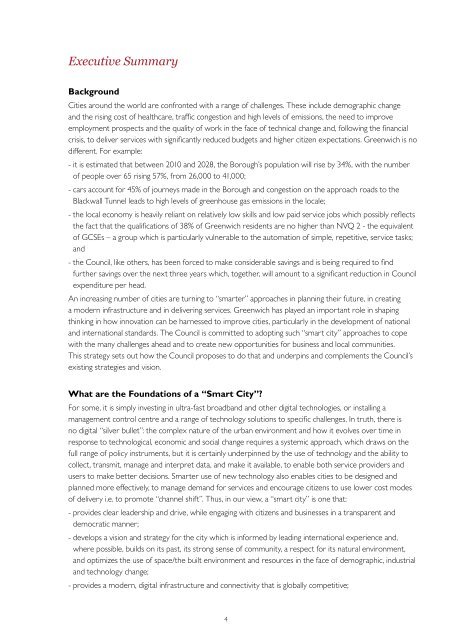Greenwich smart city strategy
You also want an ePaper? Increase the reach of your titles
YUMPU automatically turns print PDFs into web optimized ePapers that Google loves.
Executive Summary<br />
Background<br />
Cities around the world are confronted with a range of challenges. These include demographic change<br />
and the rising cost of healthcare, traffic congestion and high levels of emissions, the need to improve<br />
employment prospects and the quality of work in the face of technical change and, following the financial<br />
crisis, to deliver services with significantly reduced budgets and higher citizen expectations. <strong>Greenwich</strong> is no<br />
different. For example:<br />
-it is estimated that between 2010 and 2028, the Borough’s population will rise by 34%, with the number<br />
of people over 65 rising 57%, from 26,000 to 41,000;<br />
-cars account for 45% of journeys made in the Borough and congestion on the approach roads to the<br />
Blackwall Tunnel leads to high levels of greenhouse gas emissions in the locale;<br />
-the local economy is heavily reliant on relatively low skills and low paid service jobs which possibly reflects<br />
the fact that the qualifications of 38% of <strong>Greenwich</strong> residents are no higher than NVQ 2 - the equivalent<br />
of GCSEs – a group which is particularly vulnerable to the automation of simple, repetitive, service tasks;<br />
and<br />
-the Council, like others, has been forced to make considerable savings and is being required to find<br />
further savings over the next three years which, together, will amount to a significant reduction in Council<br />
expenditure per head.<br />
An increasing number of cities are turning to “<strong>smart</strong>er” approaches in planning their future, in creating<br />
a modern infrastructure and in delivering services. <strong>Greenwich</strong> has played an important role in shaping<br />
thinking in how innovation can be harnessed to improve cities, particularly in the development of national<br />
and international standards. The Council is committed to adopting such “<strong>smart</strong> <strong>city</strong>” approaches to cope<br />
with the many challenges ahead and to create new opportunities for business and local communities.<br />
This <strong>strategy</strong> sets out how the Council proposes to do that and underpins and complements the Council’s<br />
existing strategies and vision.<br />
What are the Foundations of a “Smart City”?<br />
For some, it is simply investing in ultra-fast broadband and other digital technologies, or installing a<br />
management control centre and a range of technology solutions to specific challenges. In truth, there is<br />
no digital “silver bullet”: the complex nature of the urban environment and how it evolves over time in<br />
response to technological, economic and social change requires a systemic approach, which draws on the<br />
full range of policy instruments, but it is certainly underpinned by the use of technology and the ability to<br />
collect, transmit, manage and interpret data, and make it available, to enable both service providers and<br />
users to make better decisions. Smarter use of new technology also enables cities to be designed and<br />
planned more effectively, to manage demand for services and encourage citizens to use lower cost modes<br />
of delivery i.e. to promote “channel shift”. Thus, in our view, a “<strong>smart</strong> <strong>city</strong>” is one that:<br />
- provides clear leadership and drive, while engaging with citizens and businesses in a transparent and<br />
democratic manner;<br />
- develops a vision and <strong>strategy</strong> for the <strong>city</strong> which is informed by leading international experience and,<br />
where possible, builds on its past, its strong sense of community, a respect for its natural environment,<br />
and optimizes the use of space/the built environment and resources in the face of demographic, industrial<br />
and technology change;<br />
- provides a modern, digital infrastructure and connectivity that is globally competitive;<br />
4


